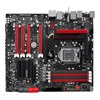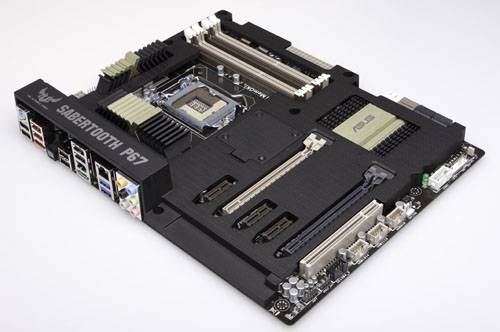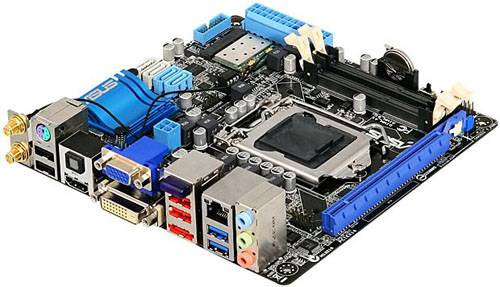- Qualcomm Launches Snapdragon 4 Gen 2 Mobile Platform
- AMD Launches Ryzen PRO 7000 Series Mobile & Desktop Platform
- Intel Launches Sleek Single-Slot Arc Pro A60 Workstation Graphics Card
- NVIDIA Announces Latest Ada Lovelace Additions: GeForce RTX 4060 Ti & RTX 4060
- Maxon Redshift With AMD Radeon GPU Rendering Support Now Available
A Look at Upcoming ASUS H67 & P67 Motherboards

Intel’s Sandy Bridge processors are rumored to be delivered within the next two months, and some proof of that is the fact that motherboard vendors are coming forth with lots of information about their upcoming product. ASUS is one of these, and has briefed us on a large collection of its H67 & P67 offerings. Let’s check ’em out.
Page 2 – Sabertooth P67 & P8P67-I; Final Thoughts
The Ultimate Force Sabertooth P67 motherboard looks dressed to please, but it is packing some heat beneath the covering. ASUS terms the cover a “vest”, and that is likely the most striking feature at first glance for this motherboard. While not pictured in the stock image, the board has an optional PCH heatsink with a fan. What makes this special is that the fan will direct airflow between the vest and the motherboard, forcing air past certain hot spots such as PCIE and PCH voltage circuitry just to name a few. While it may sound gimmicky we have seen this motherboard in action, and while we can’t disclose the numbers the result were simply impressive.
The vest may be new, but ASUS’s TUF brand has been around long enough to see both P55 and X58 variants. The TUF series targets server, enterprise, and extreme environments where reliability is the buyer’s primary consideration. Toward that goal the Sabertooth P67 features more than just solid capacitors, it has ceramic chokes and other military grade power circuitry designed to take the heat. We don’t just say that (and neither does ASUS), because these boards are subjected to a thermal shock test ranging from -40 to 85°C to ensure there are no faulty power components or weak trace contacts that might fail under temperature extremes.
ASUS also stands behind the The Ultimate Force brand, giving it a one-of-a-kind 5-year warranty, but given the build quality that shouldn’t come as a surprise. Some other features are the five additional thermal sensors built into key areas of the PCB (outside the typical sensors found on motherboards) for component and PWM monitoring, and built-in ESD surge protection that will give the motherboard a chance to survive a surge or static discharge. The connectivity options are nearly identical to the P8P67 series boards, with only the Bluetooth, coaxial SPDIF removed. The board still supports Crossfire and SLI, four SATA 6Gb/s ports, and connectivity for two front USB 3.0 ports to make a total of four.
Last but certainly not least we have perhaps the most enticing model, the mini-ITX P8P67-I. This tiny platform will come packing full support for Sandy Bridge in addition to almost everything else. Forget the kitchen sink, this tiny board can fit inside a bathroom sink instead, which is simply impressive for the features. WiFi, Bluetooth, four USB 3 ports (two rear), two rear USB 2.0 ports, gigabit LAN, three eSATA ports, 4.1 sound, digital SPDIF, multi-purpose PS/2 port, and of course HDMI, DVI, and VGA . A single full PCIE 16x slot is available as well as two SATA 6Gb/s and two SATA 3Gb/s ports. All-solid caps is of course standard.
The only drawback with this tiny board is the requirement for DDR3 SO-DIMMs, but that is understandable given full size RAM would have necessitated the removal of other features. Notebooks will help drive the prices of DDR3-1333 SO-DIMMs, potentially allowing this motherboard to be unrivaled as the basis for an HTPC, mobile computer, or even a SFF gaming PC if a discrete graphics card was added.
Some features common to all boards that we can safely mention would be the use of Digital-VRMs across the majority of ASUS’s motherboard lineup. In addition to more granular control and providing better options to modify (or completely disable) vdroop altogether, Digital-VRMs can allow for power savings through better efficiency, frequency tuning, and even a few other interesting tricks that will be made available in ASUS’s exciting looking AI Suite II package. We frankly can’t recall the last time a software application by a motherboard vender got us this excited, but from what we have seen so far, ASUS has created a real gem without any of the glaring faults that have often plagued previous motherboard utilities.
Additionally ASUS model motherboards will be offering a new granular (non-linear) approach to fan control, while also allowing VRM-like control of 3-pin fans. Although technically AMD offered this functionality first with its SB800 southbridge no motherboard venders appeared to capitalize on it. ASUS has elected to develop this functionality on its own and incorporated it into several of its Intel motherboards, with as many as five fan headers tied into this functionality on some models.
There is much more to get excited about, but until the NDA’s expire these teasers will simply have to do. Sandy Bridge is already proving to be an exciting new design but ASUS seems committed to match it with its motherboards.
Discuss this article in our forums!
Have a comment you wish to make on this article? Recommendations? Criticism? Feel free to head over to our related thread and put your words to our virtual paper! There is no requirement to register in order to respond to these threads, but it sure doesn’t hurt!
Support our efforts! With ad revenue at an all-time low for written websites, we're relying more than ever on reader support to help us continue putting so much effort into this type of content. You can support us by becoming a Patron, or by using our Amazon shopping affiliate links listed through our articles. Thanks for your support!






